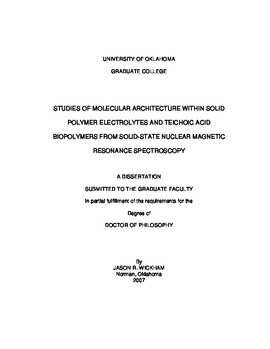| dc.contributor.advisor | Rice, Charles V., | en_US |
| dc.contributor.author | Wickham, Jason R. | en_US |
| dc.date.accessioned | 2013-08-16T12:20:53Z | |
| dc.date.available | 2013-08-16T12:20:53Z | |
| dc.date.issued | 2007 | en_US |
| dc.identifier.uri | https://hdl.handle.net/11244/1248 | |
| dc.description.abstract | The unsuccessful collection of a 31P CP-MAS spectrum in frozen D2O suggests the presence of liquid water around LTA. 2H SSNMR were used to study the phase of the water environments for LTA dissolved in D2O at -25 and -40° C. This resulted in the presence of a narrow (liquid) and broad (solid) signal at both temperatures, demonstrating that LTA is an anti-freeze agent. | en_US |
| dc.description.abstract | There is little structural information for dilute salt systems, thus we have characterize the crystalline microdomains of a 20:1 PEO:LiTf sample using the REDOR SSNMR experiment. Our data clearly demonstrates that the lithium crystalline microdomains are nearly identical to that of the crystalline 3:1 sample. | en_US |
| dc.description.abstract | Part II. Teichoic acids important to bacteria since they participate in surface adhesion, metal ion coordination, and survival at subzero temperatures. However, there is very little molecular level information available for the initial adhesion of bacteria to solid surfaces. 31P CP-MAS spectra and T1p data demonstrate that the structure of LTA changes when adhered to cellulose, PGN, or TiO2 (the structure of LTA on TiO2 is heterogeneous). However, when LTA is simultaneously adhered to PGN and TiO2 the observed structure is dependent on the amount of retained water. Our proposed structure for LTA on TiO2 has the alanine adhered to the surface with the glucosamine groups rotated toward the surface. However, simultaneous adhesion uses the glucosamine groups to adhere to PGN allowing water absorption between the LTA backbone and the TiO2 surface. Our NMR studies also demonstrate that WTA properties are very similar to LTA. | en_US |
| dc.description.abstract | The proposed Mg2+ binding structure to teichoic acids are monodentate fashion to either one phosphate or bridging between two phosphates. However, we show that Mg2+ binds in a bidentate fashion through compassion of experimental collected 31P CP-MAS spectra to a simulated 31P CPMAS spectra form an energy-minimized model compound. | en_US |
| dc.description.abstract | Part I. Understanding and assigning the 13C NMR signals are vital to interpreting the NMR data collected for each phase. Previously for pure PEO, the narrow component has been assigned to the amorphous region and the broad component to the crystalline region. Using a crystalline 3:1 PEO:LiTf sample, we assign the narrow component to the crystalline PEO:LiTf region, which is reversed from the previous pure PEO assignment. Thus, we reexamine the NMR assignments for pure PEO using samples of pure powdered PEO, thermally treated pure powdered PEO, and a thin film PEO cast from an acetonitrile solution. We observed the growth of the narrow peak under conditions that favor crystallization; therefore, we reassigned the narrow peak to the crystalline region and the broad peak to the amorphous region. | en_US |
| dc.format.extent | xix, 178 leaves : | en_US |
| dc.subject | Biopolymers. | en_US |
| dc.subject | Polyelectrolytes. | en_US |
| dc.subject | Nuclear magnetic resonance spectroscopy. | en_US |
| dc.subject | Chemistry, Physical. | en_US |
| dc.subject | Chemistry, Organic. | en_US |
| dc.title | Studies of molecular architecture within solid polymer electrolytes and teichoic acid biopolymers from solid-state nuclear magnetic resonance spectroscopy. | en_US |
| dc.type | Thesis | en_US |
| dc.thesis.degree | Ph.D. | en_US |
| dc.thesis.degreeDiscipline | Department of Chemistry and Biochemistry | en_US |
| dc.note | Source: Dissertation Abstracts International, Volume: 68-07, Section: B, page: 4499. | en_US |
| dc.note | Adviser: Charles V. Rice. | en_US |
| ou.identifier | (UMI)AAI3273884 | en_US |
| ou.group | College of Arts and Sciences::Department of Chemistry and Biochemistry | |
